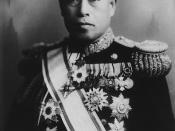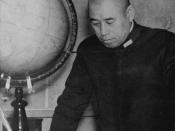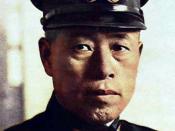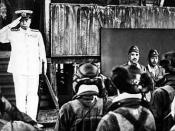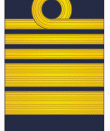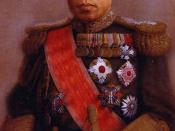Isoroku Yamamoto is considered a national hero in Japan. He is considered one of Japan's greatest naval officers of all time. He almost single-handedly commanded the entire Japan fleet, and won his country many early sea battles in World War II. But in the United States, he was portrayed as a monster, an evil second only to Hitler himself. Who was Isoroku Yamamoto? Was he a hero, or a monster?
Isoroku Yamamoto was born Isoroku Takano on April 4, 1884. He was the sixth son of Takano Sadayoshi, and his name, Isoroku, means 56, the age Takano Sadayoshi was when his sixth son was born. The boy was immediately put up for adoption, and was adopted by the Yamamoto family.
Isoroku Yamamoto graduated from Japan's imperial naval academy in 1904 at age 20. He was assigned to a cruiser, and in May 1905 he participated in the big naval battle of Tsushima Strait, where the new Japanese navy defeated the Russian navy.
Yamamoto was wounded in the left hand and leg and lost two fingers, but recovered and continued with his naval career.
In 1919, Yamamoto was sent to learn in the United States. He studied English in Harvard University, and also learned about the United States, and became familiar with the nation's strengths and weaknesses. After graduating from Harvard, Yamamoto returned to Japan and specialized in the new field of military aviation, and particularly naval aviation. In 1925, he returned to the United States as the naval attaché at the Japanese embassy in Washington, D.C. He stayed until 1936, when he returned to Japan to become the vice-minister for the Japanese Navy. By 1941, Isoroku Yamamoto became the Commander in Chief of all naval forces.
In October 1941, General Hideki Tojo became the Prime minister of Japan. Knowing that war was now inevitable, Admiral Yamamoto began think about Japan's best chance of victory. After his time in the United States, his opinion of the U.S Navy was low, and he described it as "a club of golfers and bridge players." However, Yamamoto was fully aware of the power of the United States as a nation. He knew he had to knock the US Pacific Fleet out fast if he were to have any chance. Therefore he planned a surprise long range attack on the navy base in Pearl Harbor, Hawaii.
On December 7, 1941, a Japanese task force launched over 350 fighters, bombers, and torpedo aircraft successfully attacked the naval air station and surrounding military installations, losing less than 20 aircraft and 5 midget submarines in the attack, and inflicting overwhelming damage on the naval vessels docked in the harbor. Of the approximately 100 U.S. Navy ships present in the harbor that day, eight battleships were damaged with five sunk. Eleven smaller ships including cruisers and destroyers were also badly damaged. Among those killed were 2,335 servicemen and 68 civilians. About 1,178 people were injured. The U.S.S. Arizona was dealt the worst blow of the attack. A 1,760-pound bomb struck the ship and the ammunition on board exploded, killing 1,177 servicemen.
Shortly after the attack on Pearl Harbor, Yamamoto led his navy to a decisive battle near the island of Midway, in the center of the Pacific. Unfortunately for him, the US naval intelligence knew in advance of his plan to attack Midway. They responded by attacking the Japanese aircraft carriers just as the munitions were being prepared, which exploded as the US bombed the ships. In just one day the Japanese lost their four best aircraft carriers, as well as the aircrafts and elite air crews. The US only lost one carrier. As Yamamoto predicted before the war, Japan had lost its initiative in the Pacific.
Despite these setbacks, Yamamoto continued to fight against the US navy. But luck was not on his side. The US had managed to decode another Japanese message, this one telling them of Yamamoto's intensions to visit his units in the northern Solomon Islands on April 18, 1943. Seeing this as an opportunity to eliminate its top threat in the Pacific, the US sent Admiral Nimitz, commander of the US Pacific Fleet, to intercept Yamamoto's aircraft.
The 339th fighter squadron of the US army air force, equipped with long range P-38 Lightning fighters, was informed of Yamamoto's itinerary and was ordered to intercept his aircraft. The meeting point was far in Japanese controlled air space, so 16 Lightnings were sent to intercept Yamamoto along his flight path. They arrived and loitered at low altitude for a while, until they saw their target, two G4M Betty bombers escorted by six Zero fighters. The American fighters focused on the bombers and shot down both of them and one of the Zeroes over the jungle.
Admiral Isoroku Yamamoto, the planner of the attack in Pearl Harbor, was killed. Japan was shocked by the loss of its best admiral. Yamamoto's successor said "We had only one Yamamoto and no one can replace him". Admiral Yamamoto received the highest state honors in his funeral. He was also posthumously promoted to the highest rank of Fleet Admiral, and Germany, Japan's ally, honored him too as the only foreigner awarded the Knights Cross with oak leaves and swords, one of its highest medals, awarded to Germany's most outstanding aces and military leaders.
